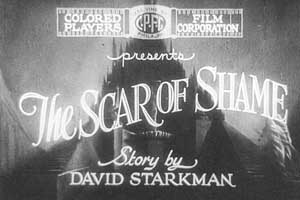Race Films Screening Schedule
Jan. 6
Within Our Gates
Oscar Micheaux, 1920, 99m, restored 35mm
With live piano accompaniment by Professor Thomas Christensen, Professor and Chairman of the Department of Music
During the summer of 1919, there were race riots in more than 20 U.S. cities. When this film was released the following year, it was censored in Chicago because its “8,000 feet of sensational realism” included references to interracial rape and lynching. Telling the story of an educated black woman with a shocking past (Evelyn Preer), Within Our Gates is Micheaux’s second film and the earliest extant feature film by an African-American director. Sponsored by the Center for the Study of Race, Politics and Culture at the University.
Jan. 13
Spying the Spy
R.W. Phillips, 1918, 13m
Two Knights of Vaudeville
Ebony Film Corporation, 1915, 13m
A Natural Born Gambler
G. W. Bitzer, 1916, 30m
With live organ accompaniment by Jay Warren
Black representation in silent cinema consists primarily of comic stereotypes, creating difficulties for black actors playing comic roles––such as the legendary Bert Williams in A Natural Born Gambler. Spying the Spy was produced by Chicago’s Ebony Film Corporation, which sought to avoid dialect and stock situations in favor of a Keystone style of “quality” slapstick.
Jan. 20
Body and Soul
Oscar Micheaux, 1924, 104m
With live jazz accompaniment by the Damian Espinosa Trio
Starring Paul Robeson as an ex-convict-turned-preacher and his twin, a mild-mannered inventor, this film is artistically and politically radical. Robeson and Micheaux used the form of double roles to expose and explore dualities within the community when its coherence and religious leadership were seen as crucial to its political advancement. Not a conventional realist work, Body and Soul violates the Hollywood codes of conventional easy-to-follow storytelling. Using flashbacks and dream sequences, Micheaux’s editing seeks simultaneity over continuity.
Jan. 27
Ten Nights in the Bar Room
Roy Calnek, 1926, 65m, 35mm
With live musical accompaniment by Funkadesi
This film, based on a popular temperance play performed in black communities, features two of the leading black stage actors of the day: Lawrence Chenault as a shady bar room proprietor and Charles Gilpin as a drunkard. The production company, the Colored Players Film Corporation, was founded in 1926 by white producer David Starkman, who produced popular melodramas about black families and communities. Ten Nights enjoyed the longest continuous run of any race film in the silent era, running four weeks at New York City’s Grant Theatre.
Feb. 3
 |
Scar of Shame
Frank Perugini, 1927, 92m
With live jazz accompaniment by Fred Anderson & Tatsu Aoki. A reception will follow.
Elite pianist Alvin (Harry Henderson) marries lower-class Louise (Lucia Lynn Moses), but their social differences cannot be reconciled. A melodrama of class conflict, this film is one of four produced by the Colored Players Film Corporation. Writer David Starkman hired a white director and white technicians but worked with an all-black cast. The film is notable for its relatively high production values and for its rare depiction of color prejudice and class tensions within the African-American community.
Feb. 10
Veiled Aristocrats
Oscar Micheaux, 1932, 44m, 35mm
Micheaux frequently recycled story material, and this film is a remake of his 1925 silent film The House Behind the Cedars, an adaptation of the novel by noted black author Charles Chestnutt. Micheaux reinterprets Chestnutt’s story: here the light-skinned heroine, Rena, subverts the “tragic mulatta” trap by enthusiastically choosing to claim her black identity and a dark-skinned black entrepreneur boyfriend. This recently rediscovered print is missing footage near the beginning, and the surviving footage is rough and may be difficult to follow.
Feb. 17
Harlem Rides the Range
Richard Kahn, 1939, 56m
Moon Over Harlem
Edgar G. Ulmer, 1939, 68m
Filmed on location at a black dude ranch near Victorville, Calif., Harlem Rides the Range is one in a series of late 1930s race film Westerns featuring Herb Jeffries as a singing cowboy hero. Jeffries plays Bob Blake, who rides to the rescue when the villain (Clarence Brooks) tries to take control of a radium mine by kidnapping the landowner’s beautiful daughter. Jeffries rose to fame as lead singer with the bands of Duke Ellington and Earl “Fatha” Hines. The film also stars its co-screenwriter, Spencer Williams. Moon Over Harlem is a musical drama featuring jazz great Sidney Bichet.
Feb. 24
The Girl in Room 20
Spencer Williams, 1946, 63m
Spencer Williams wrote and directed nearly a dozen films between 1939 and 1947 before concentrating on his role as Andrew “Hogg” Brown in the 1950s television show Amos ‘n’ Andy. In this urban melodrama, a small-town girl named Daisy Mae Walker moves to New York City hoping to become a famous singer. She befriends a number of interesting characters but also encounters the harsh realities of city life and the cutthroat world of show business. Will Daisy become disillusioned and abandon her dreams, or will she continue her quest for fame and fortune?
March 3
Juke Joint
Spencer Williams, 1947, 70m
One of the last films made by the great Spencer Williams, Juke Joint is a fun-filled all-black-cast comedy about a pair of hitchhiking con artists named Bad News Johnson and July Jones. When the two arrive in a small Midwestern town under the assumed names of Vanderbilt Whitney and Cornbread Green, they become entangled in the lives of a local family, agreeing to help train their two teen-age daughters for a beauty contest. This wild take on black family life is highlighted by musical scenes featuring the talents of Red Calhoun.
![[Chronicle]](/images/small-header.gif)